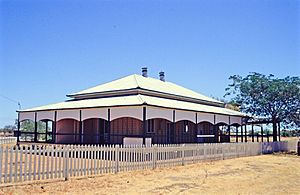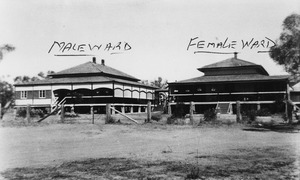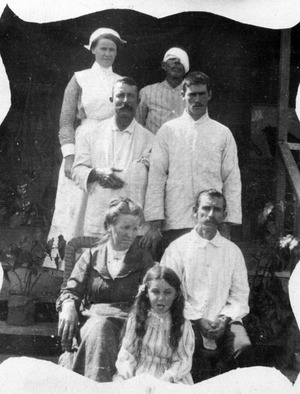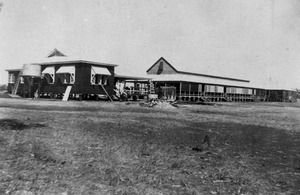Croydon Hospital Ward facts for kids
Quick facts for kids Croydon Hospital Ward |
|
|---|---|

Croydon Hospital Ward, 1994
|
|
| Location | Sircom Street, Croydon, Shire of Croydon, Queensland, Australia |
| Design period | 1870s–1890s (late 19th century) |
| Built | 1894 |
| Official name: Croydon State Emergency Services Building, Croydon Hospital Ward | |
| Type | state heritage (built) |
| Designated | 21 October 1992 |
| Reference no. | 600438 |
| Significant period | 1894 (fabric) 1890s–1980s (historical) |
| Significant components | garage, ward – enclosed |
| Lua error in Module:Location_map at line 420: attempt to index field 'wikibase' (a nil value). | |
The Croydon Hospital Ward is an old hospital building located on Sircom Street in Croydon, Queensland, Australia. It was built in 1894 and is now known as the Croydon State Emergency Services Building. This building is very important to history and is listed on the Queensland Heritage Register since 1992.
Contents
A Look Back: History of the Hospital Ward
The Croydon Hospital Ward was built in 1894. It was an important part of the Croydon Hospital, helping people who lived in the area.
Gold Rush and Early Croydon
In the early 1880s, gold was found near Croydon. This discovery led to a huge rush of people wanting to find gold. On January 18, 1886, Croydon was officially declared a goldfield.
The town grew very quickly. By the end of 1886, about 2,000 people lived there. More people meant there was a need for a hospital. The first hospital was a simple building made of wood and hessian (a type of rough fabric). Soon after, more buildings were added, including a larger ward.
Growing Town, Growing Hospital
Croydon continued to grow. By 1897, it was one of the biggest towns in North Queensland. Shipping routes and a new railway line helped the goldfields develop even more.
With a population that reached 25,000 people, the town needed a bigger hospital. So, in 1894, this second ward building was constructed. It was paid for by a large gift of money.
Changes Over Time
The goldfield's success did not last forever. After the early 1900s, less gold was found. After World War I, gold mining almost stopped completely by 1925.
As a result, many people moved away from Croydon. The town became more of a farming area than a gold mining town. The hospital sometimes struggled to stay open. The last doctor lived there in 1934. From 1953, the Royal Flying Doctor Service of Australia started visiting Croydon regularly from Cloncurry. They also offered emergency dental services.
In the early 1980s, the old hospital buildings were not suitable for modern healthcare. This ward building was moved from its original spot to its current location on Sircom and Brown Streets. Today, the Croydon Shire Council is responsible for the building.
What the Building Looks Like
The former Croydon Hospital ward building is a single-story wooden building. It sits on the corner of Sircom and Brown Streets in Croydon. A wooden picket fence surrounds the property.
Outside Features
The building is shaped like a rectangle and has a verandah all around it. Part of the verandah on the north-western side has been enclosed to create more rooms. The building is raised slightly off the ground on low posts.
The roof is shaped like a pyramid (a hipped roof) and is covered with corrugated iron. It has two vents on top to help with air flow.
Inside and Verandahs
The main entrance is through a small porch on the verandah facing Brown Street. There are also stairs at the back and side of the building. French doors open into the main hall from the ends of the building.
The verandahs are wide, about 3.7 meters. They have wooden posts and a handrail. The outside walls are made of wooden boards. The side facing Brown Street has five windows that can be opened outwards (called casement windows). Inside the main hall, the walls and ceiling are covered with fibro sheets.
Later Additions
Some parts of the verandah on the south-west side have been filled in to create extra rooms. These rooms have different types of wooden boards and smaller windows.
At the back of the property, there are two sheds. One is a corrugated iron garage with two rooms. It has a pointed roof (a gabled roof) over the rooms and a sloped roof (a lean-to) over the garage area. There is also a newer metal-covered building behind it.
Why This Place is Important
The former Croydon Hospital Ward was added to the Queensland Heritage Register on October 21, 1992. It is important for several reasons:
Showing Queensland's History
This building helps us understand how Croydon and the surrounding area developed. It shows how important the town was and how many people lived there when the goldfield was at its busiest.
Its Beautiful Design
Even though it was moved, the building's shape, size, and materials fit in with other old public buildings in Croydon. These buildings, like the former town hall and the Club Hotel, give the town its unique look.
Connection to the Community
The former hospital ward has a long history of serving the people of Croydon and the nearby areas. It was a central place for healthcare for many years, making it special to the community.




